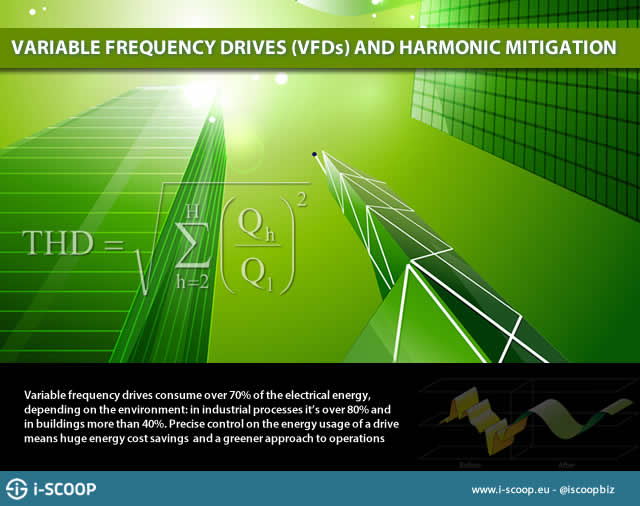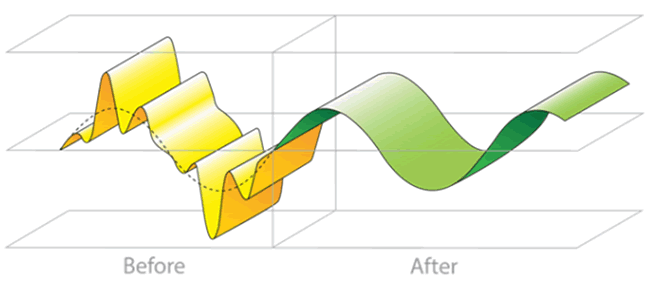How do you best manage the harmonics created by variable frequency drives? An interview with two subject matter experts with a focus on critical buildings.
Variable frequency drives (VFDs) are increasingly integrated in Industry 4.0, notably in the most critical power environments of Industrial IoT. Research indicates that the VFD market is growing due to ongoing industrialization and urbanization while drives get ‘smarter’.
Electrical devices with non-linear loads, including anything with a switch-mode power supply i.e. personal computers, LED lighting, AC and DC motor drives, will all generate some degree of harmonics.
Most, if not all harmonic compliance requirements in the world, such as IEEE 519, call for less than 5% total harmonic distortion.
The application of variable frequency drives also produces harmonic current from the output of the inverter. These harmonics can be harmful to the motor itself, and unless properly mitigated, will resonate across the larger electrical power system. Since there are many industries and applications in which various variable frequency drives are used, the solutions to deal with harmonics differ.
In this interview with Jean-Pascal Riss and Nicolas Larue from Schneider Electric we look at VFDs, harmonics and why/how to mitigate harmonics caused by variable frequency drives with a focus on critical power facilities.

Selecting the right approach for the right application is crucial for several reasons as our experts will explain. Jean-Pascal works in Schneider’s Industrial Automation division, while Nicolas works in Schneider’s Energy Management division; and conveniently enough the convergence of energy management and industrial automation is at the root of this application challenge. We’ll start our discussion with an overview of VFDs, harmonics, harmonic mitigation approaches and the reasons why it all matters.
Setting the scene: the role and energy saving benefits of variable frequency drives
Jean-Pascal, you are the Offer Category Director for the Low Voltage Variable Speed Drive (VSD) end user market at Schneider Electric. Can you explain us the role of VFDs or VSDs?
Jean-Pascal Riss: Variable speed drives are the electronic devices that today control almost all electrical motors in industrial processes with moving components, including fluids such as water or air. To control such processes, at one point you need to be able to control the speed of the involved motors.
In the past there were many technologies to do so but since give or take fifteen years we only use variable speed drives. The adoption of VSDs has been exponential. The technology is based upon the IGBT (insulated-gate bipolar transistor), a silicon device that provides different frequencies to the motor. It was first developed and used in Japan. Gradually quality improved, costs went down, and now variable speed drives are omnipresent.
Where is the demand to use them coming from?

Jean-Pascal Riss: Well, the main purpose of drives is to provide a precise regulation of electrical motors which enables energy savings. Since drives consume over 70% of the electrical energy, depending on the environment: in industrial processes it’s over 80% and in buildings more than 40%. This means precise control on the energy usage of a drive means huge energy cost savings, and a greener approach to operations. A typical example in buildings are HVAC systems (Heating, ventilation, and air conditioning) which you want to provide with just enough energy to have precisely enough cooling capacity, but not so much that you are running your motors at full speed anytime the system is turned on.
Variable frequency drives and harmonics: the challenge and the mitigation approaches
Ok, so the opportunity is clear, but what’s the downside, or implication of this pervasive use of VFDs? Nicolas Larue, with the system level approaches Jean-Pascal mentions we’re more on your domain since you are globally responsible for the AccuSine range of active power correction filters at Schneider Electric. Can you tell us more about harmonics, harmonic mitigation and this system level approach whereby such an active power correction filter is used?
Nicolas Larue: Sure, energy savings are great, but the implication of using equipment like VFDs is the generation of harmonic current which could impact electrical reliability.
Simply put a harmonic current is a frequency that is different from the fundamental frequency in an electrical network, which, depending on the country, is either 50Hz or 60Hz. When you add a device such as a VFD to an electrical network the perfect sign wave of this fundamental frequency gets distorted, and the more you use, the more this is distorted. This is often represented with THD or Total Harmonic Distortion or explained through Power Factor.
Harmonic mitigation enables us to reduce the distortions caused by changing the frequencies and adding lots of electronic components
As Jean-Pascal explained the purpose of a VFD is to alter the speed of a motor and speed in the mechanical world equals frequency in the electrical world. So, alternating the speed of the motor equals driving it at a different frequency and thus a current that exists at a different frequency. When we start changing the frequencies and add lots of electronic components we get more distortions and harmonic mitigation enables us to reduce them and thus avoid the harmful consequences they can have.
Jean-Pascal Riss: That’s right, so along with other devices which get connected to the same electrical network, variable frequency drives create a lot of harmonics. There are different ways to deal with these harmonic frequencies on the level of the drives themselves since manufacturers started making drives with embedded mitigation technology. Yet, there are also solutions to mitigate harmonics on a systems level which can be a better option, depending on the segment, application and other factors.
So there is a ‘drive embedded’ solution to the harmonics challenge, and an external system wide solution?
Nicolas Larue: Exactly, now keep in mind, Harmonic mitigation is one several power conditioning possibilities.
Power correction or conditioning addresses potential power quality issues by conditioning the electrical network of a facility or building. On top of harmonic mitigation this includes, among others, the improvement of a power factor, load balancing, filter mitigation and anything that is really messing with the current of the customer. A UPS, for instance, is also a power conditioning system.
Ok, so it’s more than just variable frequency drives?
Nicolas Larue: It can be, for example, the AccuSine product range I’m responsible for, offers several power correction or conditioning possibilities. In the scope of this interview only their harmonic mitigation capabilities matter though and there are indeed cases where they are more fit to be used with variable frequency drives.
Manufacturers of drives started embedding mitigation technology but sometimes it’s better to use a different approach and mitigate harmonics on a systems level
Perhaps it’s important to note that in the future harmonic frequency issues with VFDs will not be fully solved on the drive level as I hear people sometimes say. They believe mitigation won’t be that much of a problem anymore as manufacturers of VFDs will design better products. Yet, this is only the case to some extent as the real issue is this simple fact that to change speed of a motor you must change the current or frequency at which you’re having that current as I mentioned. It’s important to understand this.
Clear. You and Jean-Pascal both mention circumstances and applications where a drive level or system level approach could be better as we’ll explore further. However, can you give us some examples of when harmonics really start causing problems?
Nicolas Larue: High levels of harmonics typically become an important concern when there is a high likeliness of a network-wide failure or when there could be an equipment shutdown due to the exceeding of the tolerances of the operating condition of that equipment. The results can be reduced production or sometimes even worse.
Consider sensitive medical equipment in hospitals as an example of the latter, for instance. Sensitive medical equipment such as an MRI machine or CT scanner could shut down to protect itself because the distortion, caused by the harmonic current, exceeds its operating conditions – the tolerances.
An MRI machine cannot tolerate a distortion past 8% voltage distortion and can only go up to 15% current distortion. When it’s exposed to an unpure sign wave because of a handling unit or the HVAC that has VSDs, for example, we deviate from the tolerances of the operating condition of that equipment.
High levels of harmonics typically become an important concern when there is a high likeliness of a network-wide failure or when there could be an equipment shutdown
Another example that is more related to production is that of a large agriculture facility in a region where there is no connectivity to the utility grid and generators are used. If harmonic filters aren’t used here the generators wouldn’t work because the harmonic limits on the network would exceed the tolerance of the generator.
These are just some real-life examples where you immediately see why harmonic mitigation is important and not properly doing it can have significant consequences.
Jean-Pascal, Nicolas just mentioned some examples where system level active power correction filters help mitigate harmonics. Earlier you said there are several ways in which harmonics are tackled on a drive level. Before looking at when which type of mitigation approach is best used can you give an overview of the technologies/solutions on a drive level?
Jean-Pascal Riss: For starters, it’s important to keep in mind that in practice you often have a combination of different technologies to meet the requirements from the end customer which depend on multiple elements such as those types of applications.
That’s what ultimately influences the choices of drives, technologies and how to combine drive level approaches with system level approaches. As far as the drive level technologies are concerned the two main ways to deal with the harmony created by the drive that variates the speed of the motor at one point in a process: an active one and a passive one.
- With active harmonic mitigation the drive uses an additional semiconductor for the mitigation, enabling a THDi (Total Harmonic Distortion in current) of less than 5%. This additional semiconductor however also means an additional source of potential problems, more loss at a device level and thus a bigger product to be installed in the cubicle which has an impact on the footprint.
- Passive harmonic mitigation uses a passive filter for mitigation with a different level of technology which typically results in a THDi of anywhere between 10 and 20%. The technologies used can range from a very low type of mitigation to a very high one whereby the cost goes up as the mitigation compensation levels that can be achieved go up. With passive filters there is sometimes also more wiring in the device.
On top of these two main technologies we use in variable drives to limit the production of harmonics on the electrical network, there is also a very low-cost type of harmonic filtering that exists on many drives: AC line reactors and DC link chokes. They provide a good level of filtering, but they are less effective on the level of total harmonic distortion mitigation.
The optimal harmonic mitigation approach: considerations
Now that we know how harmonics can be dealt with on a drive level and/or by using AccuSine active power correction filters the question is when it’s best to use what. Are there any rules of thumb when deciding if it’s best to use drive level harmonic mitigation or rather look at such stand-alone power correction filters?
Jean-Pascal Riss: Remember that variable frequency drives are used in various markets and applications, from industrial markets to buildings.
Typically, you would do mitigation on a drive level in markets such as oil & gas or MMM (Mining, Minerals & Metals) when there are few drives with very high power. For an application in MMM, for example, you maybe have ten to twenty drives which could range from 500 kilowatts up to 2 megawatts or 6 megawatts per drive.
An important aspect to consider when it’s best to go for a system level versus a device level approach is compliance where it’s about the entire facility and the building has a limit of 5% harmonic distortion
However, in different applications in other segments where the installation is very diverse, and the drives are distributed into the system it can be easier to have a systems approach. And buildings with many drives are a typical example because the drives can be directly installed into the air handling unit, in pump systems, in the rooftop, in other words: across the whole building.
Nicolas Larue: I would add that, in general, filtering at the system level with a standalone active harmonic filter is done in situations where the solution can be scaled.

In a small facility with two drives, for instance, there is no need or argument for an AccuSine versus doing it at the device level of these two drives. However, if you take the example of a hospital or a water treatment plant where there are hundreds, if not thousands of drives, there are already economies of scale.
If you’re trying to correct the harmonic at the device level in a situation where you have one hundred drives that could potentially – depending on the electrical architecture – be mitigated maybe by two of these active harmonic filters. So, you already have a complete scale in terms of the number of drives versus the number of filtering points so to speak.
A second important aspect to consider when it’s best to go for a system level versus a device level approach is compliance. If you look at current harmonic mitigation performance on a device level the best a drive can achieve would be somewhere around 35%. Most, if not all harmonic compliance requirements in the world, such as IEEE 519, call for less than 5%. Jean-Pascal mentioned these percentages.
If you take the example of a hospital or a water treatment plant where there are hundreds, if not thousands of drives, there are already economies of scale
However, from a compliance perspective it isn’t just about the drives but about the entire facility where the building has a limit of 5% harmonic distortion. That includes all the drives and everything else, including the lighting. So, the question is how you bring down this 35% to 5%. And that’s what you can do at the system level with an active solution. It also again shows why opting for the optimal harmonic mitigation approach is important for several reasons.
Dealing with harmonic mitigation in critical power facilities
It does indeed. In another interview Kevin Morin, who is responsible for the Critical Power badge of EcoXpert, Schneider Electrics’ partner program, gave several examples of critical buildings with various types of stakeholders and partners. You are both actively working with Schneider clients in these sectors. . Do you have any advice for system integrators regarding VFDs and harmonic mitigation?
Jean-Pascal Riss: There are different forms of cross-pollination. The most important aspect is to be more selective around the solution architecture in dealing with harmonic mitigation in critical power facilities.
In other words: to look for optimization possibilities since in the end that’s what customers want and that’s the common goal for our partners in all segments as customer demands change.
Nicolas Larue: Absolutely. I think it’s important to keep in mind the regulatory dimension and be even more selective in critical power buildings precisely because of the sensitivity of some equipment used in them and the consequences of broken equipment and potentially network-wide failures.
Regarding the precise ways in which partners can look at the various cross-pollination opportunities it depends on the type of partner and, as we tackled, the applications.
Jean-Pascal Riss: Indeed. In being more selective around the solution architecture there are opportunities for panel builders but also for contractors and system integrators to work with business partners in the markets Nicolas and I serve and where there is already an overlap.
Being more selective regarding the solution architecture for harmonics mitigation is even more important in critical power buildings because of the sensitivity of some equipment used in them
I think panel builders really can benefit here. Moreover, system integrators working in industrial segments can identify opportunities and get in touch with Schneider Electric for help, training or a partnership on the level of harmonic distortion mitigation from a holistic critical power building perspective, offering more value to their clients. It’s a new business opportunity for engineers who might today focus only on topics like industrial controls.
Nicolas Larue: This also is the case on the prescription side: when advising their clients. So, there is certainly also an opportunity for system integrators to work with consulting engineers. Finally, there are possibilities for integrators to formally partner with Schneider to gain specific certification to learn more and broaden their expertise and offering.
Thank you for this interview, gentlemen!
More information about the variable speed drives from Schneider Electric via this link and an overview of the active power correction filters here.

Disclosure: this is a sponsored post in the scope of the commercial collaboration between i-SCOOP and Schneider Electric, containing links to solutions and the partner program of Schneider Electric.
Top image: Shutterstock – Copyright: antishock – All other images are the property of their respective mentioned owners.

